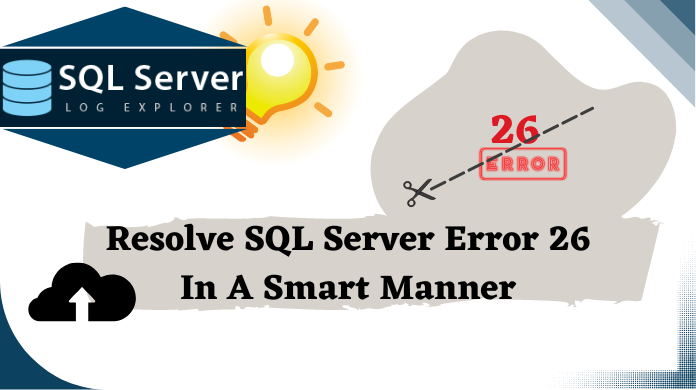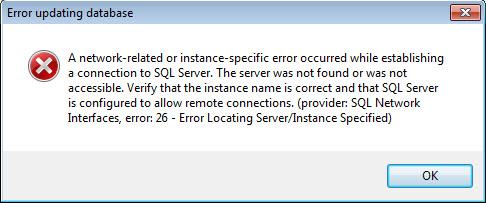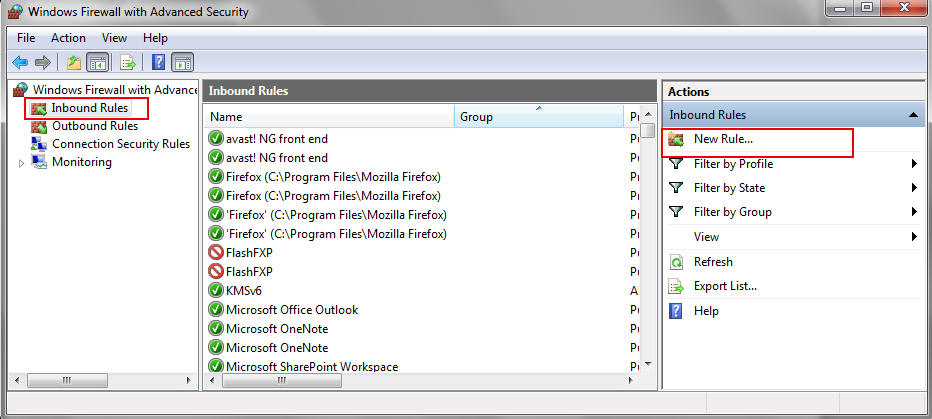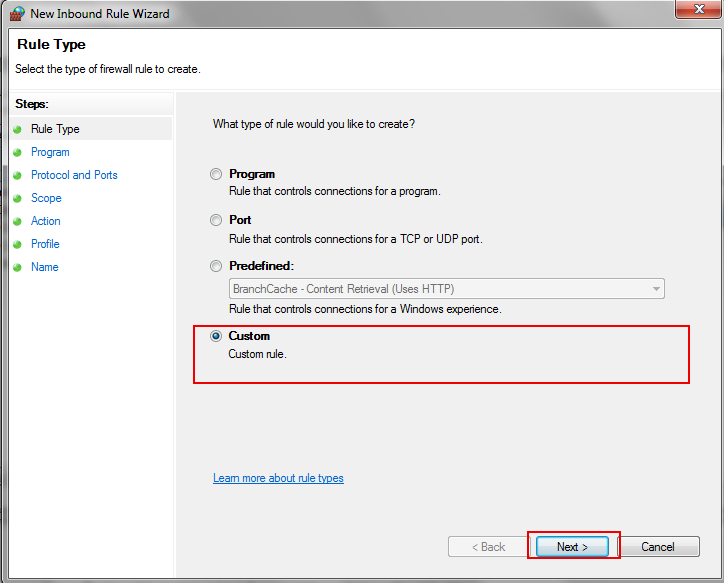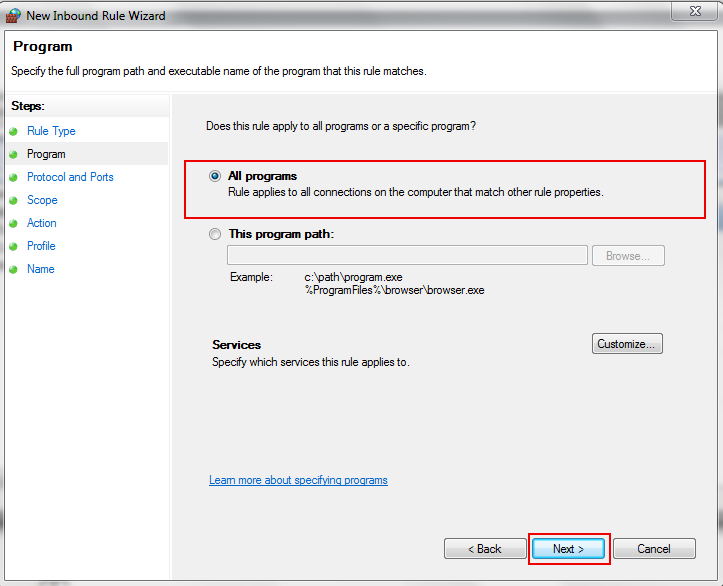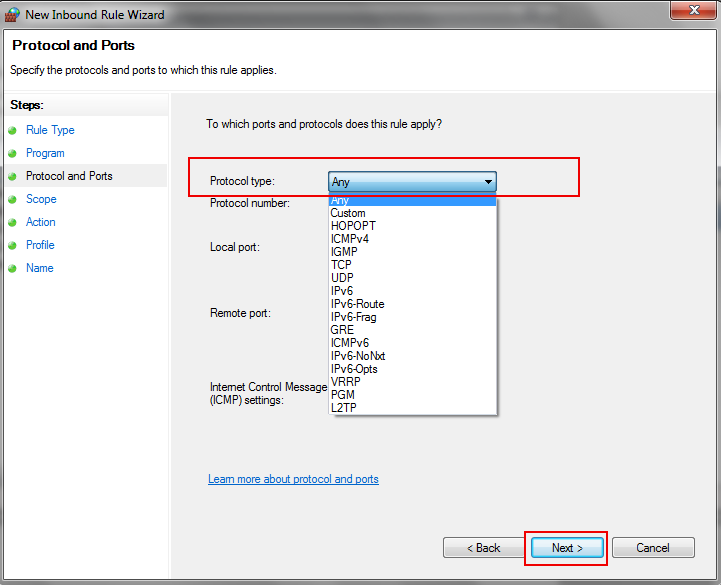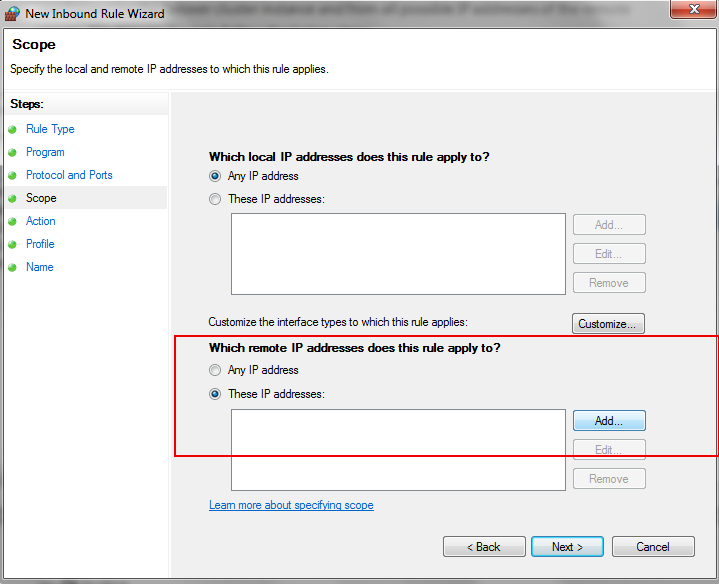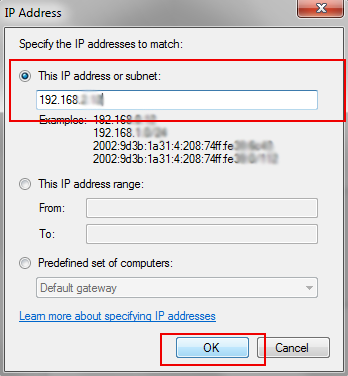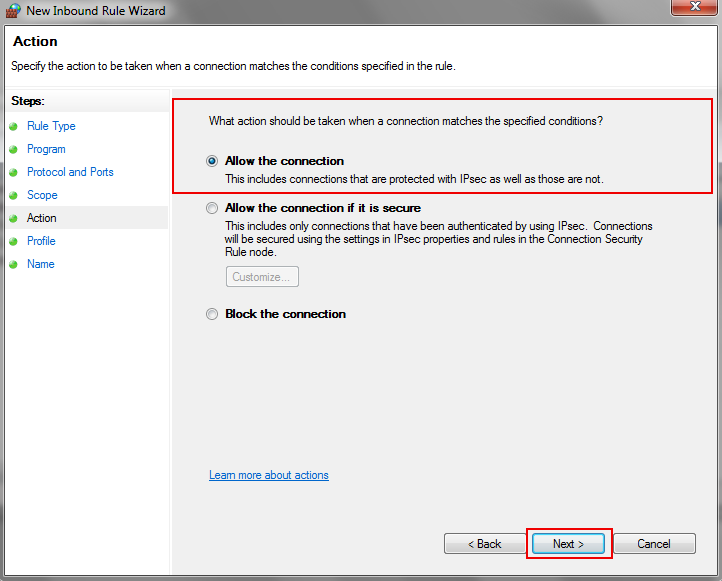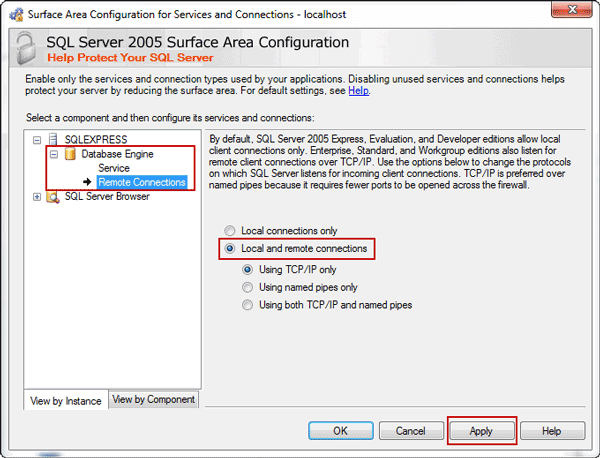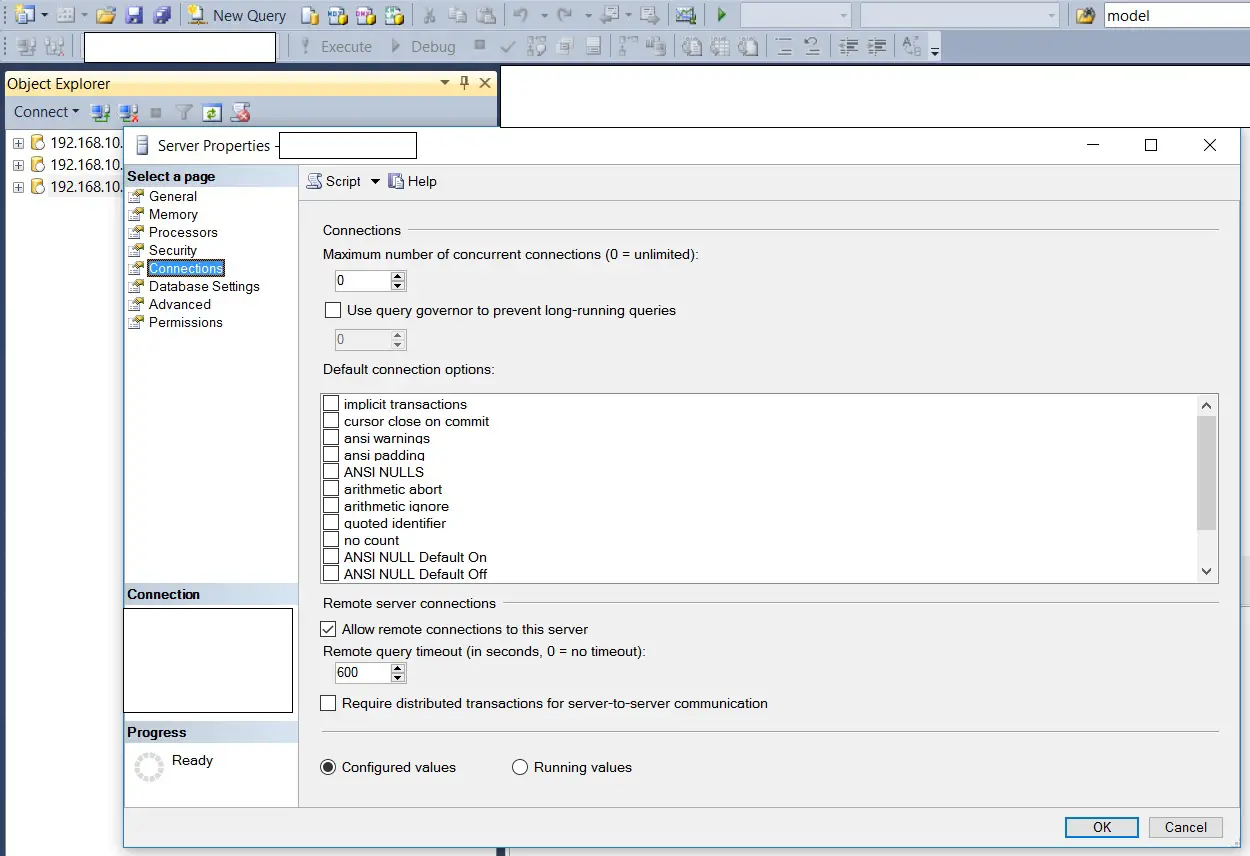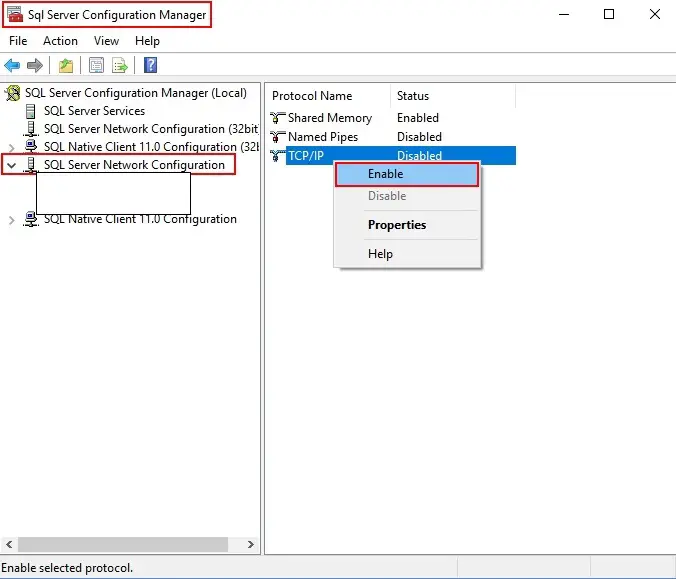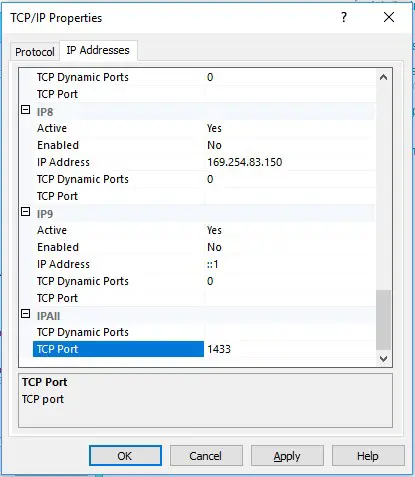This issue also confused me a few days, after the IT guy changed some security settings on the SQL Server.
I have an EntityFramework for the Web application and for a desktop application.
After I changed some settings on the SQL Server, the Web application comeback to work, but the desktop still facing issue. But I used the same connection string for both applications, it make no sense one is working but the other doesn’t.
Then I searched a lot until I found someone saying here it is needed to add port number 1433 after the $ServerName$DatabaseInstanceName,1433.
After I added it, the exception became:
System.Data.SqlClient.SqlException: Login failed for user
‘domainname-PC$’
Then I found this link. It says to add Trusted_Connection=False;.
The whole connection string should be like:
data source=XXXXXSQLSERVER,1433;initial catalog=XXXDB;user id=UserID;password=PWD;Trusted_Connection=False;MultipleActiveResultSets=True;
Hope this answer will help the ones out off Generic exception:
Error: 26-Error Locating Server/Instance Specified
Methods to Resolve SQL Server Error 26
Users often see “SQL Network Interfaces, error: 26 – Error Locating Server/Instance Specified” error message while connecting to SQL Server. This error 26 SQL server is quite common nowadays as a lot of users are complaining about it.
SQL Server Error 26 occurs when users trying to connect to a SQL Server named instance. The reason of the SQL Server Error 26 is the client stack could not receive SSRP response UPD packet from SQL Browser. Now, there a few ways to solve SQL network interfaces error 26 in a smart way. Stay tuned to know the best way.
Table of Content
- Quick Steps Guide
- Windows Firewall Method
- Other Causes of Error 26
- Automated Solution
- FAQs
Tip: Fix SQL Server Management Studio Error 40
SQL Error 26 Quick Solution in 5 Steps
- Downlaod & Launch tool in your PC
- Click on Open to Add database files
- Select Quick or Advance Scan mode
- Select Settings & Destination Location
- Click on Export button to get your results
You have to create an incoming rule that allows traffic from all promising IP addresses that are configured for the failover cluster instance and from all possible IP addresses of the remote server. For this, just follow the below steps. We’re sure that this way users can easily get rid of this SQL network interfaces error 26 for sure.
-
- Open Adminstrative Tools, from Control Panel to begin solving error 26 SQL server
- In Adminstrative Tools, click on Windows Firewall with Advanced Security
- Under Windows Firewall with Advanced Security on Local Computer column, click on the Inbound Rule and then select New Rule from the right pane
-
- From New Inbound Rule Wizard window, select Custom and then click on the Next button
-
- Under Does this rule apply to all programs or a specific program? select All programs then click on Next button
-
- Form Protocol type list, select Any and then click on Next button
-
- Under Which remote OP addresses does this rule apply to? select These IP addresses and then click on Add button
-
- In IP Address dialog box, under This IP address or subnet type the IP address and then click on Ok button
-
- Under What action should be taken when a connection matches the specified conditions? select Allow the connection and then click on Next button
- Click on the Next button to complete the New Outbound Rule Wizard steps
Other Possible Causes of SQL Server Error 26 with Solution
SQL Server does not allow remote connections
- To resolve the SQL Server Error 26 open SQL Server Management Studio, Right click on the database and select properties
- On Security page, select SQL Server and Windows Authentication mode and click on Ok button
- Restart SQL Server
If you are still facing the Error 26, then there could be a same name conflict between two systems. Check whether the computer name, system name is same if yes, then try to system using its IP address. In addition this error 26 occurs with several issues that are mentioned below:
- SQL network interfaces, error: 26 – error locating server/instance specified
- provider: SQL network interfaces, error: 26 – error locating server/instance specified
- a network related or instance specific error in SQL server error 26
Experts’ Recommended Solution to Counter Errors Causes Due to Corruption
Now when there is some sort of data corruption issues present in the server, the SQL database might react differently than what it should usually do. Therefore, experts often suggest users to get the automated repair & recovery tool.
Downlaod the tool & then follow easy steps to repair damaged data & solve SQL network interfaces error 26 with ease. In addition, if you want to know how to make SQL server faster then this tool can remove corruption as well. Ultimately resulting in a faster server.
Download Now Purchase Now
Step-1. Launch the Tool in your system & then Click the Open button.
Step-2. Select the Quick or Advanced Scan Mode as per your need.
Step-3. Set the SQL Server database details to continue further.
Step-4. Finally, Click on the Export button to finish the task.
Frequently Asked Questions
Q-1. What is connection error 26 in SQL Express?
A: It is crucial for users to ensure that the name of their server is correct & no typo on the name is present. Always make sure that your SQL browser service is running on the server in case you are trying to connect SQL instance on another server. Your machine should be reachable.
Q-2. How do I fix error code 26?
A: The device drivers of your system are closely connected to the error 26. Removing all external devices can be a solution too here.
Q-3. What is SQL Server error 26 client unable to establish connection because an error was encountered during handshakes before login?
A: The most common reason for this is when a client connects to a unsupported version of SQL Server. Here the the error occurs because the server is too busy to accept the new connections. In some cases, resource limitation is also an issue where maximum allowed connected are pre defined.
Q-4. How do I fix SQL query error?
A: There are 4 steps to fix SQL query error as mentioned below:
- Navigate to the failing line in SQL query.
- Check failing SQL syntax in SQL query.
- Check query logic in joins, subqueries, or CTEs.
- Go to troubleshooting error messages to finish.
Q-5. How to restart SQL Server?
A: Go to SQL Server Configuration Manager >> Select SQL Server Services, Right Click a named instance or SQL Server> Select from Start, Stop, Pause, Resume & Restart options.
Q-6. How do I allow remote access to SQL Server database?
A: 5 Steps to allow remote access to SQL Server database:
- Start SSMS (SQL Server Management Studio)
- Go to Object Explorer & Right Click on Server
- Select Properties & then Click Connections
- Enable Allow Remote Connections to this Server
- Click on Ok to save & Finish the task.
For me the issue was that the DNS record was wrong…
The following, which proved very helpful, is largely taken from this blog post.
This error message is actually pretty specific and the solution quite simple.
You get this error message only if you are trying to connect to a SQL Server named instance. For a default instance, you never see this because even if we failed at this stage (i.e. error locating server/instance specified), we will continue to try connect using default values, e.g default TCP port 1433, default pipe name for Named Pipes.
Every time a client makes a connection to SQL Server named instance, we will send a SSRP UDP packet to the server machine UDP port 1434. We need this step to know configuration information of the SQL instance, e.g., protocols enabled, TCP port, pipe name etc. Without this information the client does not know how to connect and it fails with this error message.
In a word, the reason that we get this error message is the client stack could not receive SSRP response UDP packet from SQL Browser. In order to isolate the exact issue follow these steps:
-
Make sure your server name is correct, e.g., no typo on the name.
-
Make sure your instance name is correct and there is actually such an instance on your target machine. (Be aware that some applications convert to ).
-
Make sure the server machine is reachable, e.g, DNS can be resolve correctly, you are able to ping the server (not always true).
-
Make sure the SQL Browser service is running on the server.
-
If the firewall is enabled on the server, you need to put sqlbrowser.exe and/or UDP port 1434 into exception.
There is one corner case where you may still fail after you checked steps 1 to 4. It also may happen when:
- your server is a named instance on cluster or on a multi-homed machine
- your client is a Vista machine with Firewall on.
A tool which could prove useful (it did for me) is PortQry. If this command returns information and it contains your target instance, then you can rule out possiblity 4) and 5) above, meaning you do have a SQL Browser running and your firewall does not block SQL Browser UDP packet. In this case, you can check other possible issues such as an incorrect connection string.
As a final note, the error message for the same issue when you use SNAC is:
[SQL Native Client]SQL Network Interfaces: Error Locating Server/Instance Specified [xFFFFFFFF].
Microsoft recently released a guided walk through that can serve as a one stop shop to troubleshoot a majority of connectivity issues to SQL Server: Solving Connectivity errors to SQL Server
- Remove From My Forums

provider: SQL Network Interfaces, error: 26 — Error Locating Server/Instance Specified
-
Question
-
I used profile for shopping cart
Collapse
<system.web>
<anonymousIdentification enabled="true"/>
<customErrors mode="Off"></customErrors>
<profile enabled="true">
<properties>
<add name="SCart" serializeAs="Binary" type="Tandis.Cart" allowAnonymous="true"/>
</properties>
</profile>
</system.web>Server Error in ‘/’ Application.
A network-related or instance-specific error occurred while establishing a connection to SQL Server. The server was not found or was not accessible. Verify that the instance name is correct and that SQL Server is configured to allow remote connections.
(provider: SQL Network Interfaces, error: 26 — Error Locating Server/Instance Specified)Description: An unhandled exception occurred during the execution of the current web request.
Please review the stack trace for more information about the error and where it originated in the code.Exception Details: System.Data.SqlClient.SqlException: A network-related or instance-specific error occurred while establishing a connection to SQL Server. The server was not found
or was not accessible. Verify that the instance name is correct and that SQL Server is configured to allow remote connections. (provider: SQL Network Interfaces, error: 26 — Error Locating Server/Instance Specified)Source Error:
Line 19: public virtual Tandis.Cart SCart { Line 20: get { Line 21: return ((Tandis.Cart)(this.GetPropertyValue("SCart"))); Line 22: } Line 23: set {Source File: c:windowsMicrosoft.NETFrameworkv2.0.50727Temporary ASP.NET Filesroot2faf057937b1b4f4App_Code.1mhfv5r1.3.cs
Line: 21Stack Trace:
[SqlException (0x80131904): A network-related or instance-specific error occurred while establishing a connection to SQL Server. The server was not found or was not accessible. Verify that the instance name is correct and that SQL Server is configured to allow remote connections. (provider: SQL Network Interfaces, error: 26 - Error Locating Server/Instance Specified)] System.Data.SqlClient.SqlInternalConnection.OnError(SqlException exception, Boolean breakConnection) +4849719 System.Data.SqlClient.TdsParser.ThrowExceptionAndWarning(TdsParserStateObject stateObj) +194 System.Data.SqlClient.TdsParser.Connect(ServerInfo serverInfo, SqlInternalConnectionTds connHandler, Boolean ignoreSniOpenTimeout, Int64 timerExpire, Boolean encrypt, Boolean trustServerCert, Boolean integratedSecurity, SqlConnection owningObject) +4863021 System.Data.SqlClient.SqlInternalConnectionTds.AttemptOneLogin(ServerInfo serverInfo, String newPassword, Boolean ignoreSniOpenTimeout, Int64 timerExpire, SqlConnection owningObject) +90 System.Data.SqlClient.SqlInternalConnectionTds.LoginNoFailover(String host, String newPassword, Boolean redirectedUserInstance, SqlConnection owningObject, SqlConnectionString connectionOptions, Int64 timerStart) +376 System.Data.SqlClient.SqlInternalConnectionTds.OpenLoginEnlist(SqlConnection owningObject, SqlConnectionString connectionOptions, String newPassword, Boolean redirectedUserInstance) +221 System.Data.SqlClient.SqlInternalConnectionTds..ctor(DbConnectionPoolIdentity identity, SqlConnectionString connectionOptions, Object providerInfo, String newPassword, SqlConnection owningObject, Boolean redirectedUserInstance) +189 System.Data.SqlClient.SqlConnectionFactory.CreateConnection(DbConnectionOptions options, Object poolGroupProviderInfo, DbConnectionPool pool, DbConnection owningConnection) +4864151 System.Data.ProviderBase.DbConnectionFactory.CreatePooledConnection(DbConnection owningConnection, DbConnectionPool pool, DbConnectionOptions options) +31 System.Data.ProviderBase.DbConnectionPool.CreateObject(DbConnection owningObject) +433 System.Data.ProviderBase.DbConnectionPool.UserCreateRequest(DbConnection owningObject) +66 System.Data.ProviderBase.DbConnectionPool.GetConnection(DbConnection owningObject) +499 System.Data.ProviderBase.DbConnectionFactory.GetConnection(DbConnection owningConnection) +65 System.Data.ProviderBase.DbConnectionClosed.OpenConnection(DbConnection outerConnection, DbConnectionFactory connectionFactory) +117 System.Data.SqlClient.SqlConnection.Open() +122 System.Web.DataAccess.SqlConnectionHolder.Open(HttpContext context, Boolean revertImpersonate) +87 System.Web.DataAccess.SqlConnectionHelper.GetConnection(String connectionString, Boolean revertImpersonation) +221 System.Web.Profile.SqlProfileProvider.GetPropertyValuesFromDatabase(String userName, SettingsPropertyValueCollection svc) +772 System.Web.Profile.SqlProfileProvider.GetPropertyValues(SettingsContext sc, SettingsPropertyCollection properties) +433 System.Configuration.SettingsBase.GetPropertiesFromProvider(SettingsProvider provider) +258 System.Configuration.SettingsBase.GetPropertyValueByName(String propertyName) +132 System.Configuration.SettingsBase.get_Item(String propertyName) +102 System.Web.Profile.ProfileBase.GetInternal(String propertyName) +36 System.Web.Profile.ProfileBase.get_Item(String propertyName) +68 System.Web.Profile.ProfileBase.GetPropertyValue(String propertyName) +7 ProfileCommon.get_SCart() in c:windowsMicrosoft.NETFrameworkv2.0.50727Temporary ASP.NET Filesroot2faf057937b1b4f4App_Code.1mhfv5r1.3.cs:21 Showbook.Button2_click(Object sender, EventArgs e) in c:inetpubvhoststandisbooks.irhttpdocsShowbook.aspx.cs:22 System.Web.UI.WebControls.ImageButton.OnClick(ImageClickEventArgs e) +108 System.Web.UI.WebControls.ImageButton.RaisePostBackEvent(String eventArgument) +118 System.Web.UI.WebControls.ImageButton.System.Web.UI.IPostBackEventHandler.RaisePostBackEvent(String eventArgument) +10 System.Web.UI.Page.RaisePostBackEvent(IPostBackEventHandler sourceControl, String eventArgument) +13 System.Web.UI.Page.RaisePostBackEvent(NameValueCollection postData) +36 System.Web.UI.Page.ProcessRequestMain(Boolean includeStagesBeforeAsyncPoint, Boolean includeStagesAfterAsyncPoint) +1565
Version Information: Microsoft .NET Framework Version:2.0.50727.4206; ASP.NET Version:2.0.50727.4209
it works locally on IIS but on the host it gives this error!
what should I do ? (my host is plesk 9.5 )
Answers
-
Hi Nima,
Thank you for your post.
The reasons for throwing this issue could be wrong server name, disabled remote connection
and firewall blocking.Could you please follow the steps below to solve this issue?
· Check the server on which SQL Server is running can be accessible. You can use ping command to test that. For instance, ping <computer_name> or ping <IP_address>.
The ping command may be block by the firewall, make sure ICMP is enabled in the firewall. More info, check:http://technet.microsoft.com/en-us/library/cc739791%28v=ws.10%29.aspx#BKMK_4.
· Choose appropriate protocol
· Configure Windows firewall accordingly based on what protocol you have chosen to use. For detailed information about how to configure Windows Firewall to allow SQL Server,
please check http://msdn.microsoft.com/en-us/library/cc646023.aspx.· Enable SQL Server Browser Services
You need to enable SQL Server Browser Services if the following are both true:
1. SQL Server is not listening on default 1433 port or not use default pipe name
\.pipesqlquery;2. The corresponding TCP port or pipe name is not specified in the connection string (such as Srv1SQL2008, 1500).
If you have enabled SQL Server Browser Services, you still need to open UDP 1434 port which is used by Browser Services in the Windows firewall.
Best Regards,
Peja TaoPlease remember to click «Mark as Answer» on the post that helps you, and to click «Unmark as Answer» if a marked post does not actually answer your question. This can be beneficial to other community members reading the thread.
-
Proposed as answer by
Friday, March 18, 2011 6:36 AM
-
Marked as answer by
Alex Feng (SQL)
Friday, March 25, 2011 4:19 AM
-
Proposed as answer by
ПК работает медленно?
Улучшите скорость своего компьютера сегодня, загрузив это программное обеспечение — оно решит проблемы с вашим ПК. г.
Если вы столкнулись с ошибкой SQL Server 26, указывающей на то, что клиент не может подключиться к вашей системе, надеюсь, это руководство желательно должно помочь.Сетевые интерфейсы SQL, ошибка: Twenty-Six — ошибка обнаружения на указанном сервере/экземпляре. Пользователи обычно понимают сообщения об ошибках при подключении к SQL-хостингу и не знают, с чего начать их замечать. эта проблема. На большинстве форумов указано, что удаленное соединение в настоящее время не включено на сервере.
Часть 1. Исправление ошибки подключения SQL 2003 Server 25
Как исправить ошибку 26 в SQL Server ?
Чтобы устранить ошибку SQL Server 26, откройте SQL Server Management Studio, щелкните правой кнопкой мыши базу данных, связанную с выбранными свойствами.На странице «Безопасность» выберите «SQL Server и режим проверки подлинности Windows» и нажмите «ОК».Перезапустите SQL Server.
Если это просто сбой провайдера, попробуйте удаленно открыть внешнее соединение SQL Server 2003. Откройте удаленную связь в конфигурации контактной зоны SQL Server. Если вы
1) Убедитесь, что ваше имя на форуме можно исправить, например, в названии действительно нет опечаток. 3) Убедитесь, что веб-сервер компьютера доступен, для позиции, DNS будет корректно разрешен, вам нужно определить эхо-сервер (не совсем корректно). 4) Убедитесь, что служба SQL Browser работает на хост-сервере в Интернете.
Убедитесь, что службы SQL запущены
, как вы могли заметить! Если вы используете SQL Server для использования всего имени экземпляра и обычно практически не используете определенное количество портов TCP/IP в строке диалога, вы должны запустить агентство обозревателя SQL Server, чтобы разрешить удаленные подключения. /p>
Презентация
В этой статье описывается, как настроить экземпляр SQL Server Database Engine для прослушивания определенного фиксированного порта с помощью SQL Configuration Server Manager для исправления ошибки sql 27. В предыдущей персонализированной статье я подробно рассказал о точном размере таблиц базы данных, который определяется просто данные SQL на сервере, в частности, пример по умолчанию, подключенный к механизму базы данных SQL Server, отвечает (прослушивает) на TCP-порту 1433. События, называемые базой данных SQL и, следовательно, механизмом Сервер организован компактно для увлекательных портов. Это означает, что если вы выберете их доступный порт, SQL Management Server будет запускаться гораздо чаще. Если вы взаимодействуете с именованным экземпляром через брандмауэр, настройте информационный механизм для прослушивания определенного подключаемого модуля в соответствии с тем, что соответствующий порт может быть открыт в брандмауэре.
Как включить удаленные подключения в SQL Server?
Щелкните правой кнопкой мыши весь сервер в обозревателе объектов и выберите «Свойства».Щелкните новый узел «Подключения».В разделе «Подключения к удаленному серверу» установите или снимите флажок «Разрешить удаленные подключения для помощи этому серверу».
Решение:
7 способов решить ошибку SQL Server 26, которая действительно связана с подключением Windows ПК/клиент за пределами Windows Server/SQL Server для (установлен SQL Server) и получения ошибки SQL двадцать пять, то выше, нам нужно сравнить:
Улучшите скорость своего компьютера сегодня, загрузив это программное обеспечение — оно решит проблемы с вашим ПК. г.
Почему мой клиент не может подключиться к серверу?
Клиент не может принять в описание соединение, так как произошла ошибка при начале контакта перед сохранением. Общие причины заключаются в том, что обычно клиент пытается подключиться к нуждающейся в поддержке версии SQL Server, сервер, конечно, занят, чтобы принимать расширенные соединения, или материалы (память или максимально допустимые соединения) на типе сервера сокращаются. .
Почему я получаю сообщение об ошибке, связанной с сетью и, например, с конкретным экземпляром?
При построении ссылки на SQL Server произошла ошибка, связанная с сетью или экземпляром. Сервер еще не запущен или недоступен. Убедитесь, что имя времени указано правильно или что SQL Server несомненно настроен на разрешение удаленных подключений.
Как исправить ошибку двадцать пять в SQL Server?
Пользователи часто видят сообщение об ошибке «Сетевые интерфейсы SQL, ошибка: ошибка 26 — когда указанный сервер/экземпляр был найден» при подключении, чтобы помочь вам SQL Server.
Как исправить код ошибки SQL?
Если вы получаете доступ к коду ошибки SQL десять, проверьте, установлена ли и запущена ли служба SQL.
Как включить удаленные отношения в SQL Server?
Этот раздел относится ко всем функциям удаленного доступа. Этот параметр конфигурации представляет собой любую скрытую функцию связи между SQL Server и SQL Die, которая устарела и, вероятно, не должна использоваться. Если вы попали на эту страницу сжатия из-за проблем с подключением к SQL Server, вместо этого найдите один из следующих разделов:
Fix SQL Server Error 26, Client Cannot Connect
SQL 인터넷 호스팅 서버 오류 26 수정, 클라이언트가 연결할 수 없음
SQL-computerfout 26 Repareren, Client Kan Geen Verbinding Maken
Napraw Błąd 26 Serwera Hostingowego SQL, Klient Nie Może Się Połączyć
SQL-Serverfehler 26 Beheben, Client Kann Keine Verbindung Herstellen
Corregir El Error 26 Del Servidor SQL, El Cliente No Puede Conectarse
Risolto L’errore 26 Del Server SQL, Il Client Non Può Connettersi
Corrigir O Erro 26 Do Servidor SQL, O Cliente Não Pode Se Conectar
Corrigez L’erreur 26 Du Périphérique SQL, Le Client Ne Peut Pas Se Connecter
Åtgärda SQL-serverfel 28, Klienten Kan Inte Ansluta
г.
SQL Server Error 26 and SQL Server Error 40 appear when you try to connect to SQL Server. We will troubleshoot and try to fix them in the same article as both are related to connection issue. We recommend to use the below solutions for the both errors and to try to localize the problem.
The error Messages:
(provider: SQL Network Interfaces, error: 26 – Error Locating Server/Instance Specified)”
A network-related or instance-specific error occurred while establishing a connection to SQL Server. The server was not found or was not accessible. Verify that the instance name is correct and that SQL Server is configured to allow remote connections. (provider: SQL Network Interfaces, error: 26 – Error Locating Server/Instance Specified)
“ Named Pipes Provider Error: 40 – Could not open a connection to SQL Server“.
A network-related or instance-specific error occurred while establishing a connection to SQL Server. The server was not found or was not accessible. Verify that the instance name is correct and that SQL Server is configured to allow remote connections. (provider: Named Pipes Provider, error: 40 – Could not open a connection to SQL Server)
A network-related or instance-specific error occurred while establishing a connection to SQL Server. The server was not found or was not accessible. Verify that the instance name is correct and that the SQL Server is configured to allow remote connections. (provided: Named Pipes Provider, error: 40- Could not open a connection to the SQL Server) (Microsoft SQL Server, Error: 2).
sql server error 26
SQL Server Error 26 and SQL Server Error 40
What is SQL Server Error 26?
You will get this error message while trying to connect to a SQL Server named instance and not when you use default instance. The client stack could not receive SSRP response UDP packet from SQL Browser.
How to fix Error 26 on SQL Server?
- Recheck the server name for any error and fix it
- Check the instance name for any error
- Check if SQL Server browser is running
- Control if this instance exist on server
- Ping the server and check if DNS can be resolved correctly
What is SQL Server Error 40?
This error appears mostly when SQL Server does not allow remote connections, Firewall Settings or TCP/IP is not enabled. We will explain below all those in order to troubleshoot easy.
Read also other SQL Server Helping Posts:
- How to fix SQL Server Error 229
- Fix SQL Server Error 233
- SQL Server Error 17002
How to fix error 40 on SQL Server?
- Check SQL Server is running
- Make sure that Allow Remote Connections is enabled on sql server properties
- Check if TCP/IP is enabled
- Configure to allow SQL Server in Firewall Settings
- Check for working fine SQL Server Browser
- Make sure that you can ping the SQL Server
Below we will explain the above steps in long way for better understanding and easy fix of SQL error 26 and sql error 40.
1. Check if SQL Services are running
Hint! If you are running SQL Server by using an instance name and you are not using a specific TCP/IP port number in your connection string, you must enable the SQL Server Browser service to allow for remote connections.
How to check if SQL Server Service is running?
- Go to SQL Server Configuration Manager > SQL Server Services
- Find the service SQL Server (MSSQLSERVER) if default or the name of your instance
- Check if is running – should be running state with a green indication
Using Windows Command Prompt
sc query mssqlserver
For named instance name use below by by replacing instancename with the actual SQL Server instance name.
sc query mssql$instancename
How to check if SQL Server Browser is running?
- Navigate to SQL Server Configuration Manager > SQL Server Services
- Find the SQL Server Browser Service
- Check if it is configured to start automatically and is started – should be with a green indication
Using Windows Command Prompt
sc query sqlbrowser
Check if SQL Server Service
2. Try to Flush DNS
How to flush DNS?
- Click Start Button
- Type CMD and press enter
- Type this into the black window that appears: ipconfig /flushdns and press enter.
Fluish DNS
3. Make sure that allow Remote Connection is enabled
Check if remote connections is allowed for applications/client. This option need to be allowed to establish connections and perform operations on the server. Often this is the reason of SQL Server Error 26 and SQL Server Error 40.
How to check if the remote connection is enabled?
- Open ‘SQL Server Management Studio’
- Right click on database name and select ‘Properties’
- In ‘Properties’ window, select ‘Security’, enable `SQL Server and Windows Authentication mode` and click `OK`.
- Now restart the SQL server.
Allow Remote Connections
4. Check Firewall
Check the firewall status for any troubles:
- Open ‘Control Panel’ and after that ‘Windows Firewall’.
- Select ‘Change Settings’ In ‘Windows Firewall’,
- Add an exception for port ‘1434’ and name it ‘SQL Server’
- Enable by clicking on the checkbox
5. Connection String
This solution is on cases when you are using connection string and are you writing it wrongly. For example connection string used by .NET framework:
Server=serverAddress;Database=dbName;User Id=username;
Password=password;
- Check for each parameter passed in the connection string for any typographical errors.
- Control the validity of the username/password.
- Confirm if the given database exists.
6. TCPIP Protocol
This solutions can work when you have mix of default and named instance or named instances only.
How to Enable TCP/IP port?
- Open SQL Server Configuration Manager
- Click on SQL Server Network Configuration and click on Protocols for Name
- Right-click on TCP/IP
- Click Enable
- Restart your SQL Server instance
Enable TCP-Ip port
If you want to use a static port for your instance (instead of dynamic that changes after every restart) you can change it here.
- Open Properties for TCP/IP protocol
- Go to IP Addresses tab
- Scroll down to IPAll section
- Remove 0 value from TCP Dynamic Ports
- Specify your port in TCP Port
You can use this port to connect to your instance by providing <servername>,<port> or <IP>,<port> as Server Name (yes, there is a comma, not a colon).
TCP-Ip static port
Conclusion:
We have explained some solutions to fix SQL Server Error 26 and SQL Server Error 40 and hope that you find the fix on those solutions. The both errors are included on the same article because they have almost the same troubleshoot. If you have any other solution worked for you comment below and we will try to include it on our article.
Error Description:
SQL server error 26- Unable to connect to SQL Express Error: 26-Error Locating Server/Instance Specified
A network-related or instance-specific error occurred while establishing a connection to SQL Server. The server was not found or was not accessible. Verify that the instance name is correct and that SQL Server is configured to allow remote connections. (provider: SQL Network Interfaces, error: 26 – Error Locating Server/Instance Specified) (Microsoft SQL Server, Error: -1)
Error Details: this sql server error 26 error locating server instance message is often encountered when connection to a SQL Server is tried and don’t know where to start to solve the problem.
We get this sql server error 26 error message only when we are trying to connect to a SQL Server named instance.
Every time we try to make a connection to SQL Server named instance, we will send a SSRP UDP packet to the server machine UDP port 1434. We need this step to know configuration information of the SQL instance, e.g., protocols enabled, TCP port, pipe name etc. Without these information, client does know how to connect the server and it fails with this specified error message sql server error 26 error locating server instance.
Other Errors related:
provider: named pipes provider, error: 40 – could not open a connection to sql server which is covered here.
Solution:
7 ways for resolving the sql server error 26 which is for connecting from Windows PC/Client to Windows server/SQL Server (server with SQL Server installed) and are getting the sql error 26 above then we need to check following:
On Windows SQL Server if we are trying to connect to Named instance then 1-2 steps are related. If default instance then all other steps for resolving sql server error 26 error locating server instance
- Make sure the the Windows service called “SQL Server Browser” is started.
- Make sure Windows Firewall is enabled for incoming port UDP 1434 that is we need to put sqlbrowser.exe and/or UDP port 1434 into exception.
- Make sure Windows Firewall is enabled incoming port TCP 1433. Below are steps in general for exceptions in firewall.
- You must build an incoming rule that accepts traffic for SQL Server or from all IP addresses defined for the failover cluster instance, as well as any possible distant server IP addresses. To do so, simply follow the steps below.
- From the Control Panel, go to Adminstrative Tools.
- Select Windows Firewall with Advanced Security from the Administrative Tools menu.
- Click Inbound Rule in the Windows Firewall with Advanced Security on Local Computer column, then New Rule in the right pane.
- Advanced Security for Windows Firewall
- Select Custom from the New Inbound Rule Wizard box, then click the Next button.
- Choose Custom.
- Is this regulation applicable to all programmes or just one in particular? After selecting All Programs, click the Next button. All Programs should be selected
- Select Any from the list of protocol types, then click the Next button.
- Choose a protocol type
- Which remote IP addresses are affected by this rule? After selecting these IP addresses, click the Add button.
- These IP Addresses Should Be Considered. Type the IP address under This IP address or subnet in the IP Address dialogue box, then click the Ok button.
- When a connection meets the required criteria, what action should be taken? Allow the connection to be established, then click the Next button.
- Allow the connection to happen. Select Next from the drop-down menu.
- You must build an incoming rule that accepts traffic for SQL Server or from all IP addresses defined for the failover cluster instance, as well as any possible distant server IP addresses. To do so, simply follow the steps below.
- Make Sure in SQL Server Configuration Manager that TCP/IP protocol is enabled and is set to to 1433(can be changed if needed)
- Make sure your server name is correct that is no typo on the name.
- Make sure your instance name is correct and there is actually such an instance on your target machine.
- Make sure the server machine is reachable that is DNS can be resolved correctly and we are able to ping the server (not always true as ping is disabled sometimes for security).
Additional Solutions for SQL server error 26
Make sure your database engine is configured to accept remote connection. Right click on instance to go to properties page and make sure its enabled to accept remote connections.
If we are connecting to a named SQL Server instance, make sure that instance name in your connection string is right. Usually the format needed to specify the database server is Servernameinstancename or in your connection string is right format with right instance name.

